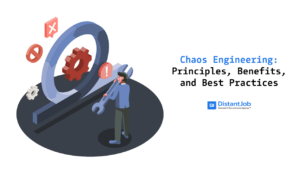The problem with poor software is that it doesn’t just taint your image — you also lose revenue. Customers will likely turn to your competitors if your software product is subpar.
According to reports, the cost of poor-quality software in 2022 grew to $2.4 trillion.
That’s why software engineering best practices are essential. They guide developers to improve software quality, promote team collaboration, and help improve maintainability and scalability.
We have curated a list of the best practices in software development in 2024. Whether you’re leading a team of experienced engineers or newbies, these practices can help ensure your project’s success.
8 Essential Practices for Software Engineers to Implement
There are many software development practices that we can’t possibly cover in this piece. But here are eight practical tips to guide your team in 2024.
1. Choose the Right SDLC Model
The Software Development Life Cycle is a structural process that enables the production of high-quality, cost-effective software within a short time. It is available in different formats and types, including Agile, Scrum, Kanban, Waterfall, and more.
Before starting any software project, understand its requirements and select the most appropriate SDLC model.
For example, if the project requirements are straightforward and for small-scale usage, the Waterfall SDLC model would be suitable. On the other hand, the Agile methodology is a better fit if the project has dynamic needs and a flexible budget and will cover a large-scale audience with dynamic requirements.
Likewise, you should examine every project’s needs and details about SDLC methodologies for building a solid foundation.
2. Keep Pull Requests or Change Lists Small
When submitting code for review, it is best to make smaller pull requests (PR) or change lists, not larger ones. One of the main reasons for this is that it makes the job of the code reviewer easier.
Nothing is worse as a code reviewer than reviewing 1,000 or 2,000 lines of code. And because reviewing that many lines of code is difficult, it is easier for a bug to introduce itself in the pull request and eventually into the central repository.
Also, it makes it more challenging if the requester eventually has to fix the pull request because some bug made its way into the main code repository. The more codes you have in a PR, the more likely there will be a merge conflict.
This is an especially useful practice if you work at a big company like Google or Facebook, where many engineers work on the same code repository. So, try to air on the side of smaller pull requests.
That might mean the requester has to put in more effort because they’ll have to break up their code into pieces that can be submitted as separate pull requests. But it will go a long way to improve the entire software development process.
3. Solve One Bug at a Time
This also has to do with pull requests. When sending out a pull request, the developer needs to limit that PR to a single, logical unit of code.
Here’s what we mean: engineers should fix one bug in their PR, not two, three, or ten —one bug. Unless they can fix two bugs with one line of code, each pull request should be limited to a single, logical thing.
The reasoning here is quite similar to the previous best practice. You want to minimize whatever a pull request is doing so to make the code reviewer’s life easy. In addition, it reduces the chance of introducing other types of bugs.
So, if there’s a need to revert the pull request, it won’t be to two different locations. Let’s say in a code base, only one location needs to be reverted — it just makes life easier.
Some people may find this annoying and tedious. But it goes a long way when working with many other software engineers on a big repository.
Of course, depending on your team, you might adhere to this best practice in either stricter or loser terms.
4. Over-Communicate When Leaving Comments on Code Reviews
One of the worst things that can happen in a code review is to leave unclear comments to the receiver (who wrote the code). It defeats the aim of the requested feedback and leaves them confused.
Suppose you want a receiver to make a change. In that case, ensure the receiver understands the change you’re requesting. Perhaps you don’t feel strongly about a comment that you left; you want to make sure they know that.
For example, if you leave a comment in a code review that is merely a suggestion — meaning you don’t care whether they address them or not — follow up with a comment and say, “I don’t really feel strongly about this, though. Use your judgment.”
That lets the receiver know they can decide whether or not to act on that comment.
Another type of clarity you can put in a comment is by saying, “Hey, Sanity check: is this what you meant to do here, or is this why you’re doing this here?” Then, you can add a follow-up comment saying, “By the way, this is non-actionable. I’m just asking for clarity.”
The idea is to be overwhelmingly clear to the person you’re doing a code review for. This way, they understand your intentions and don’t feel blocked afterward. This goes a long way when working with a remote team, people in different time zones, or cross-teams you may not have a rapport with.
As you embrace this practice, it will positively impact your team. During peer reviews, they communicate better, leading to better collaboration and software quality.
5. Integrate Idempotency in ETL Pipelines
Another software development best practice is to ensure (whenever possible) that your ETL (Extract, Transform, Load) pipelines are idempotent.
Idempotency ensures that each execution of the ETL pipeline produces the same result, regardless of how many times it is run. It is an essential feature of data pipelines since it can prevent issues with data quality and make the pipelines more resilient to failures and retries.
There are several ways to achieve idempotency in an ETL pipeline. However, it depends on the type and format of the data, the tools and frameworks used, and the pipeline-specific requirements. Some of the standard methods include the following:
- Delete-write pattern: With this method, you will delete the existing data in the output destination before writing new data. This ensures there is no existing data that conflicts with the output. The caveat is that this technique can be inefficient and risky because it requires a full scan and deletion of the output data. This can cause data loss if the write operation is unsuccessful. So, this method is best for small datasets that do not change frequently.
- Upset or merge operation: You update or insert new data into the output destination using a primary key or condition. This ensures the output contains only new or modified data, and existing data is preserved or overwritten as necessary. However, this method depends on conditional logic and input and output data comparison, making it complex and expensive. This approach is best for dynamic data sets that change frequently.
- Watermark and checkpoint: With the watermark and checkpoint method, you track the progress of the timeline using a timestamp or a sequence number indicating the last batch or record processed. This results in the output destination receiving only new or unprocessed data from the input source. The downside of this method is that it can be unreliable and inconsistent because it depends on the accuracy and availability of the watermark or checkpoint. Streaming or incremental datasets with a clear order and partition are best suited for this method.
Idempotency is one of the “cool” things that separates experienced and newbies. ETL pipelines are relatively easy to make, but creating an idempotent pipeline is a remarkable piece of engineering.
6. Don’t Overly Optimize or Modularize Upfront
You complicate the code and risk improving runtime inconsequentially when you optimize early. Instead, get a clean, clear algorithm and prioritize it later. Similarly, trying to make the system modular and extensible should be done moderately. Wait until a need arises, or you risk making the wrong interfaces and wasting time and resources.
7. Gain a Deeper Understanding of High-Level Abstraction Tools
If your team members are using tools in the pipeline that offer high-level abstractions — for example, dbt (data build tool) — they need to understand the intricacies of the lower-level operations.
Some developers shrug this off. They insist that the point of these tools is that the engineer doesn’t need to know what’s going on under the hood.
However, the widespread use of these tools in recent years has resulted in a population of engineers who aren’t competent enough to troubleshoot issues beyond the abstraction layer. Reliance on managed service with huge customer support teams has also contributed to this.
Plus, understanding the internal workings of high-level abstraction tools can help create cleaner, more efficient, and maintainable code.
8. You Don’t REALLY Need to Avoid No-code/Low-code
Sticking with tools —this is a controversial one. Software developers have mixed feelings about using no-code/low-code platforms.
Developers against these platforms argue that they limit customization and control, leading to potential performance and security issues.
This argument is valid. But sometimes, you don’t have the people or capacity to make a full-fledged pipeline. And even if you do, there are usually competing priorities. In these situations, low-code solutions can be a beneficial compromise.
So, don’t hesitate to use no-code/low-code tools when necessary. It doesn’t make you a bad developer.
Build with the Right Software Development Team
Software engineering best practices ensure developers build maintainable, scalable, and secure software products.
We have shared eight software engineering practices that can enhance the outcome of your software projects. However, this is not an exhaustive list. The technology industry constantly evolves, so it can be tricky to keep up with the latest trends, especially when you’re looking for talent.
That’s where we can help at DistantJob. We can help you find and vet potential hires to ensure they stay up-to-date with industry trends. Our culture-centric approach ensures that the candidates not only have the technical skills but also fit well into your company’s culture.
In addition, we take care of all the HR processes, from finding suitable candidates to onboarding them. This enables you to focus on building your software products and growing your business. Ready to get started? Contact us!




